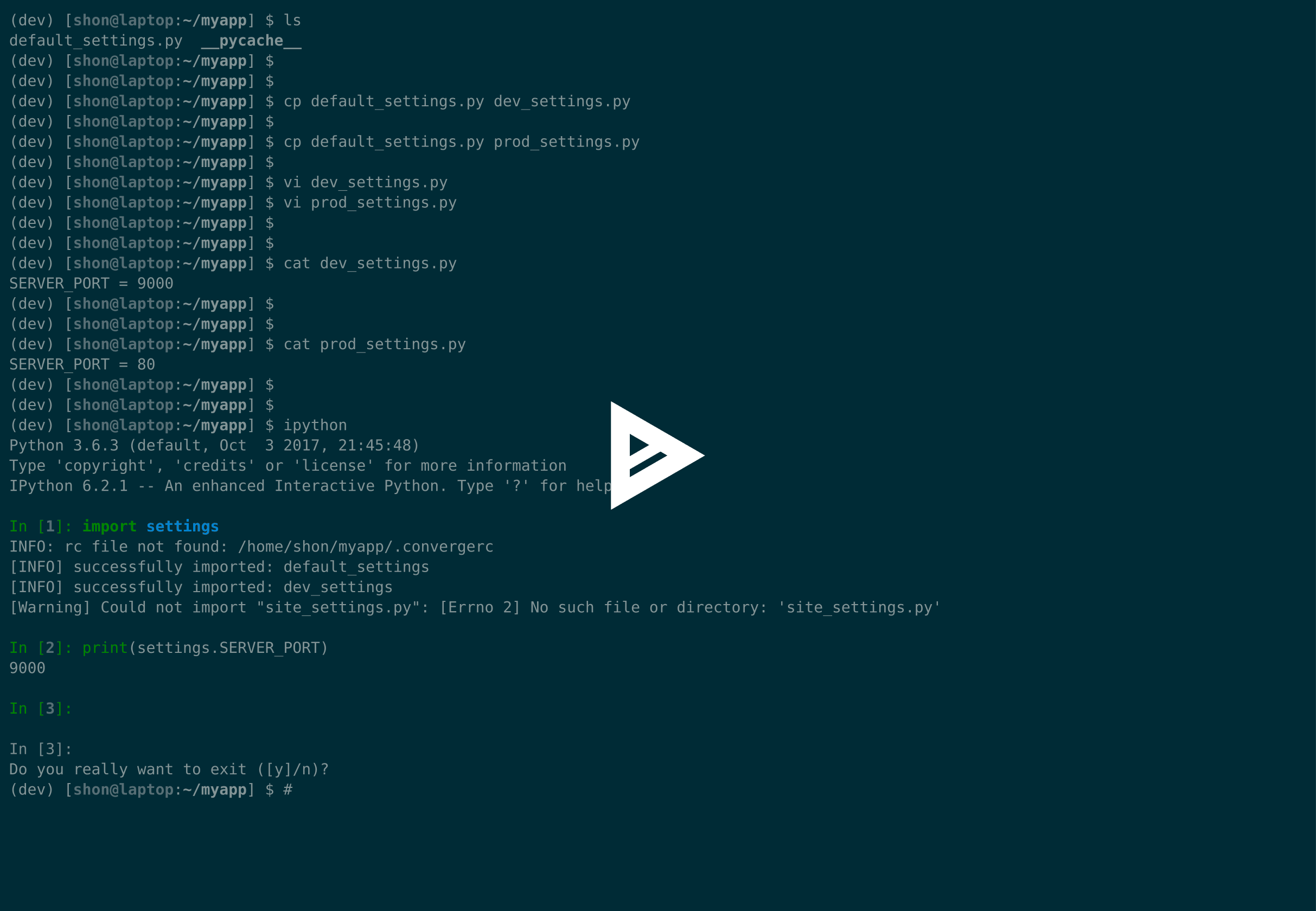Ultra simple settings management for (only) Python apps
Project description
1 What is it?
If you are a Python developer who likes to keep application configuration in simple Python modules and that your app have some default settings and production/dev/test setting files, converge can help you merge settings and load desired application settings.

2 Getting started
2.1 Easy to use
default_settings.py
-------------------
SERVER_PORT = 8000
DOMAIN = 'example.com'
ADMIN_EMAIL = 'admin@example.com'
dev_settings.py
---------------
SERVER_PORT = 9000import settings
print(settings.SERVER_PORT) # 9000
print(settings.DOMAIN) # example.com
print(settings.get('VAR_THAT_DOESNT_EXIST')) # None2.2 Install
pip install converge3 .convergerc
.convergerc file helps converge choose application mode and in turn load correct settings file.
3.1 Supported directives
_All directives are optional._
APP_MODE
Valid values are
prod
dev
test
staging
beta
Based on mode appropriate settings module would be used (if available)
SETTINGS_DIR
If your settings files are in different directory, use SETTINGS_DIR to point converge to correct path.
GIT_SETTINGS_REPO
Fetching application settings from a git repository is supported too. If such configuration is specified, git repository is cloned into SETTINGS_DIR.
GIT_SETTINGS_SUBDIR
In case you - use same git repository to host configurations of more than one applications and - say settings files are in different subdirectories
Example
my-git-repo/ | |- myapp1 | | | |- default_settings.py | |- prod_settings.py | | |- myapp2
cat .convergerc SETTINGS_DIR = 'appsettings' GIT_SETTINGS_REPO = 'git@github.com:shon/converge-test-settings.git' GIT_SETTINGS_SUBDIR = 'myapp1'
In this case all *_settings.py files in myapp1/ would be copied to appsettings.
Example
.convergerc ----------- APP_MODE = 'test' SETTINGS_DIR = 'settings' GIT_SETTINGS_REPO = 'git@github.com:shon/converge-test-settings.git' GIT_SETTINGS_SUBDIR = 'myapp1'
4 Supported settings files
Defaults: default_settings.py
- Mode
production: prod_settings.py
development: dev_settings.py
test: test_settings.py
staging: staging_settings.py
beta: beta_settings.py
Deployment specific: site_settings.py
5 Guidelines
Settings files are usual Python files that can contain valid python code however here are some guidelines for user
Use module variables for global application wide configuration
Use UPPERCASE while naming settings variables
For values prefer basic python datatypes such as string, integer, tuples
eg. SERVER_PORT = 1234
Avoid complex python operations
- Use simple classes for config sections
class DB: HOST = 'db.example.com' PORT = 1234
- Use simple string operations to avoid repetition
BASE_DOMAIN = 'example.com' API_URL = 'api.' + BASE_DOMAIN``
6 Overriding settings
Defining module veriables in site_settings.py
6.1 Example
default_settings.py
SERVER_PORT = 9999
site_settings.py
SERVER_PORT = 8888
7 Overriding partial settings
Example:
default_settings.py
class DB:
HOST = 'db.example.com'
PORT = 1234site_settings.py
DB.PORT = 11118 (Slightly) Advanced usage
In case if you want to keep all settings.py files in a directory. Use SETTINGS_DIR directive in .convergerc file.
8.1 Using SETTINGS_DIR
>> cat .convergerc
APP_MODE = 'prod'
SETTINGS_DIR = 'settings/fat_server'This is useful when you have to deploy multiple instances of an app with different configs
`-- settings/
|
|-- server1/
| |
| |--default_settings.py
| |--prod_settings.py
|
|-- server2/
| |--default_settings.py
| |--prod_settings.py
|
|
8.2 Using environment variables
It is possible use environment variables, which is useful in cases wheere you want to start multiple instances of same app directory. Any of the supported directive can exported as environment variable.
export SETTINGS_DIR='settings/site1'
gunicorn --workers=2 service:app
export SETTINGS_DIR='settings/site2'
gunicorn --workers=2 service:appProject details
Release history Release notifications | RSS feed
Download files
Download the file for your platform. If you're not sure which to choose, learn more about installing packages.
Source Distribution
File details
Details for the file converge-1.0.2.tar.gz.
File metadata
- Download URL: converge-1.0.2.tar.gz
- Upload date:
- Size: 5.2 kB
- Tags: Source
- Uploaded using Trusted Publishing? No
- Uploaded via: twine/3.2.0 pkginfo/1.5.0.1 requests/2.24.0 setuptools/44.0.0 requests-toolbelt/0.9.1 tqdm/4.46.1 CPython/3.8.5
File hashes
| Algorithm | Hash digest | |
|---|---|---|
| SHA256 | 0740fcd833209972bafb3eae90c4d2932a4c4d31c5761499e9bf3e70ec25403f |
|
| MD5 | 9a6e0a74607d768160e0984399381f8e |
|
| BLAKE2b-256 | bc79e2990da609ba677f6b2be1edd13a8999451b1e0a7ee4c4be93f237ab7170 |











